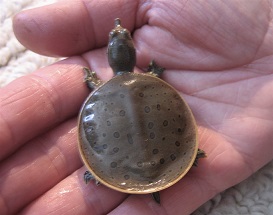Eastern Spiny Softshell Turtle (Apalone spinifera spinifera)
Description: The eastern spiny softshell is a medium to large turtle with dark spots on fore and hind limbs, a small ridge on each side of the snorkel-like snout, and small bumps or spines on the front of the carapace (top shell).
The color of the carapace varies with sex and age. Young females and males of any age have an olive or gray-tan carapace with a black line along the margin and distinct small black dots and circles. The circular markings (ocelli, or eyespots) may have a dark center. Adult females have a dark olive or tan carapace with brown and gray blotches.
Spiny softshells have a plain, cream-colored plastron (lower shell); the underlying bones can be seen through the skin.
The upper surfaces of the head, neck, and limbs are tan or olive with small brown or black markings above; the throat is grayish white with small, dark gray markings. A yellow stripe, bordered by dark brown, extends from the snout through each eye and along the sides of the head. Another light stripe runs from the angle of the jaw onto the neck.
Habitat: The eastern spiny softshell mainly inhabits large rivers and streams, but it also lives in lakes, large ponds, and even roadside and irrigation ditches. It is most common in tributaries and closed side channels of the Mississippi River. This species can tolerate a variety of bottom substrates, including mud, sand, or gravel.
Range: This species is the most widely distributed softshell turtle in North America. This could be due to habitat fragmentation caused by humans. The spiny softshell has a wide range, extending throughout much of the United States, as well as north into the Canadian provinces of Ontario and Quebec. As of recently, the spiny softshell has expanded its geographic range into Washington State and California. They were also recently discovered in Lake Champlain despite the historical records.
Diet: This species eats a variety of aquatic prey, including crayfish, insects, earthworms, snails, small mussels, fish, and tadpoles.
Reproduction: This species is active from March to October. Courtship and mating occur in April and May, and eggs are laid from late May through July. The gravid female will select a sand or gravel bar, or a sandy opening, usually near water to nest, but suitable nest sites can be a considerable distance from water. The nest is a flask-shaped chamber about 4 to 10 inches deep. Females lay 3 to 39 eggs in a clutch. Larger females usually lay more eggs. There can be up to 3 clutches per season. The eggs hatch from late August to October, after incubating for 65 to 85 days. The shells of young turtles are about 1� to 1� inches long. Female spiny softshells become sexually mature about age 8 or 9; males become mature at about age 4.
Status: Widespread, cryptic and locally common species with an adaptable life history and high reproductive potential by turtle standards. Harvest rates appear not significant enough to have led to documented localised declines. It is listed as Least Concern.
»» Kingdom: Animalia - Animals
»» Phylum: Chordata - Chordates
»» Subphylum: Vertebrata - Vertebrates
»» Class: Reptilia - Reptiles
»» Order: Testudines - Turtles & Tortoises
»» Family: Trionychidae - Softshell Turtle
»» Genus: Apalone
»» Species: Apalona spinifera - Spiny Softshell Turtle
»» Subspecies: Apalone spinifera spinifera - Eastern Spiny Softshell Turtle
This article uses material from the Wikipedia article "Spiny Softshell Turtle", which is released under the Creative Commons Attribution-Share-Alike License 3.0. Content may have been omitted from the original, but no content has been changed or extended.
|








